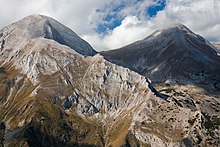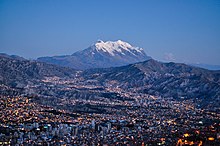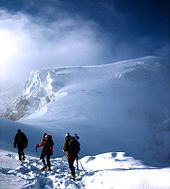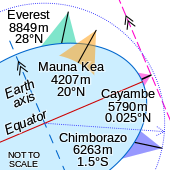Mountain

A mountain is an elevated portion of the Earth's crust, generally with steep sides that show significant exposed bedrock. Although definitions vary, a mountain may differ from a plateau in having a limited summit area, and is usually higher than a hill, typically rising at least 300 metres (980 ft) above the surrounding land. A few mountains are isolated summits, but most occur in mountain ranges.[1]
High elevations on mountains produce
The highest mountain on Earth is Mount Everest in the Himalayas of Asia, whose summit is 8,850 m (29,035 ft) above mean sea level. The highest known mountain on any planet in the Solar System is Olympus Mons on Mars at 21,171 m (69,459 ft).
Definition

There is no universally accepted definition of a mountain. Elevation, volume, relief, steepness, spacing and continuity have been used as criteria for defining a mountain.[5] In the Oxford English Dictionary a mountain is defined as "a natural elevation of the earth surface rising more or less abruptly from the surrounding level and attaining an altitude which, relatively to the adjacent elevation, is impressive or notable."[5]
Whether a landform is called a mountain may depend on local usage. John Whittow's Dictionary of Physical Geography[6] states "Some authorities regard eminences above 600 metres (1,969 ft) as mountains, those below being referred to as hills."
In the United Kingdom and the Republic of Ireland, a mountain is usually defined as any summit at least 2,000 feet (610 m) high,
The
- Class 1: Elevation greater than 4,500 m (14,764 ft).
- Class 2: Elevation between 3,500 m (11,483 ft) and 4,500 m (14,764 ft).
- Class 3: Elevation between 2,500 m (8,202 ft) and 3,500 m (11,483 ft).
- Class 4: Elevation between 1,500 m (4,921 ft) and 2,500 m (8,202 ft), with a slope greater than 2 degrees.
- Class 5: Elevation between 1,000 m (3,281 ft) and 1,500 m (4,921 ft), with a slope greater than 5 degrees and/or 300 m (984 ft) elevation range within 7 km (4.3 mi).
- Class 6: Elevation between 300 m (984 ft) and 1,000 m (3,281 ft), with a 300 m (984 ft) elevation range within 7 km (4.3 mi).
- Class 7: Isolated inner basins and plateaus less than 25 km2 (9.7 sq mi) in area that are completely surrounded by Class 1 to 6 mountains, but do not themselves meet criteria for Class 1 to 6 mountains.
Using these definitions, mountains cover 33% of Eurasia, 19% of South America, 24% of North America, and 14% of Africa.[15]: 14 As a whole, 24% of the Earth's land mass is mountainous.[16]
Geology
There are three main types of mountains:
Volcanoes

Volcanoes are formed when
Fold mountains

Fold mountains occur when two plates collide: shortening occurs along thrust faults and the crust is overthickened.[20] Since the less dense continental crust "floats" on the denser mantle rocks beneath, the weight of any crustal material forced upward to form hills, plateaus or mountains must be balanced by the buoyancy force of a much greater volume forced downward into the mantle. Thus the continental crust is normally much thicker under mountains, compared to lower lying areas.[21] Rock can fold either symmetrically or asymmetrically. The upfolds are anticlines and the downfolds are synclines: in asymmetric folding there may also be recumbent and overturned folds. The Balkan Mountains[22] and the Jura Mountains[23] are examples of fold mountains.
Block mountains

Block mountains are caused by
Erosion
During and following uplift, mountains are subjected to the agents of
Climate

Climate in the mountains becomes colder at high elevations, due to an interaction between radiation and convection. Sunlight in the visible spectrum hits the ground and heats it. The ground then heats the air at the surface. If radiation were the only way to transfer heat from the ground to space, the greenhouse effect of gases in the atmosphere would keep the ground at roughly 333 K (60 °C; 140 °F), and the temperature would decay exponentially with height.[31]
However, when air is hot, it tends to expand, which lowers its density. Thus, hot air tends to rise and transfer heat upward. This is the process of
The presence of water in the atmosphere complicates the process of convection. Water vapor contains latent
The effect of the climate on the ecology at an elevation can be largely captured through a combination of amount of precipitation, and the biotemperature, as described by Leslie Holdridge in 1947.[34] Biotemperature is the mean temperature; all temperatures below 0 °C (32 °F) are considered to be 0 °C. When the temperature is below 0 °C, plants are dormant, so the exact temperature is unimportant. The peaks of mountains with permanent snow can have a biotemperature below 1.5 °C (34.7 °F).
Climate change
Mountain environments are particularly sensitive to anthropogenic climate change and are currently undergoing alterations unprecedented in last 10,000 years.[35] The effect of global warming on mountain regions (relative to lowlands) is still an active area of study. Observational studies show that highlands are warming faster than nearby lowlands, but when compared globally, the effect disappears.[36] Precipitation in highland areas is not increasing as quickly as in lowland areas.[36]
Climate change has started to affect the physical and ecological systems of mountains. In recent decades mountain ice caps and glaciers have experienced accelerating ice loss.[38] The melting of the glaciers, permafrost and snow has caused underlying surfaces to become increasingly unstable. Landslip hazards have increased in both number and magnitude due to climate change.[39] Patterns of river discharge will also be significantly affected by climate change, which in turn will have significant impacts on communities that rely on water fed from alpine sources. Nearly half of mountain areas provide essential or supportive water resources for mainly urban populations,[40] in particular during the dry season and in semiarid areas such as in central Asia.
Alpine ecosystems can be particularly climatically sensitive. Many mid-latitude mountains act as cold climate refugia, with the ecosystems occupying small environmental niches. As well as the direct influence that the change in climate can have on an ecosystem, there is also the indirect one on the soils from changes in stability and soil development.[41]
Ecology

The colder climate on mountains affects the plants and animals residing on mountains. A particular set of plants and animals tend to be adapted to a relatively narrow range of climate. Thus, ecosystems tend to lie along elevation bands of roughly constant climate. This is called altitudinal zonation.[42] In regions with dry climates, the tendency of mountains to have higher precipitation as well as lower temperatures also provides for varying conditions, which enhances zonation.[15][43]
Some plants and animals found in altitudinal zones tend to become isolated since the conditions above and below a particular zone will be inhospitable and thus constrain their movements or dispersal. These isolated ecological systems are known as sky islands.[44]
Altitudinal zones tend to follow a typical pattern. At the highest elevations, trees cannot grow, and whatever life may be present will be of the
Mountains and humans
The highest known permanently tolerable altitude is at 5,950 metres (19,520 ft).[46] At very high altitudes, the decreasing atmospheric pressure means that less oxygen is available for breathing, and there is less protection against solar radiation (UV).[15] Above 8,000 metres (26,000 ft) elevation, there is not enough oxygen to support human life. This is sometimes referred to as the "death zone".[47] The summits of Mount Everest and K2 are in the death zone.
Mountain societies and economies
Mountains are generally less preferable for human habitation than lowlands, because of harsh weather and little level ground suitable for agriculture. While 7% of the land area of Earth is above 2,500 metres (8,200 ft),[15]: 14 only 140 million people live above that altitude[48] and only 20-30 million people above 3,000 metres (9,800 ft) elevation.[49] About half of mountain dwellers live in the Andes, Central Asia, and Africa.[16]

With limited access to infrastructure, only a handful of human communities exist above 4,000 metres (13,000 ft) of elevation. Many are small and have heavily specialized economies, often relying on industries such as agriculture, mining, and tourism.[50] An example of such a specialized town is La Rinconada, Peru, a gold-mining town and the highest elevation human habitation at 5,100 metres (16,700 ft).[51] A counterexample is El Alto, Bolivia, at 4,150 metres (13,620 ft), which has a highly diverse service and manufacturing economy and a population of nearly 1 million.[52]
Traditional mountain societies rely on agriculture, with higher risk of
Most of the world's rivers are fed from mountain sources, with snow acting as a storage mechanism for downstream users.[15]: 22 More than half of humanity depends on mountains for water.[53][54]
In
Mountaineering

Mountain climbing, or alpinism is the sport, hobby or profession of hiking, skiing, and climbing mountains. While mountaineering began as attempts to reach the highest point of unclimbed big mountains it has branched into specializations that address different aspects of the mountain and consists of three areas: rock-craft, snow-craft and skiing, depending on whether the route chosen is over rock, snow or ice. All require experience, athletic ability, and technical knowledge of the terrain to maintain safety.[57]
Mountains as sacred places
Mountains often play a significant role in
Superlatives

Heights of mountains are typically measured
The highest mountains are not generally the most voluminous. Mauna Loa (4,169 m or 13,678 ft) is the largest mountain on Earth in terms of base area (about 2,000 sq mi or 5,200 km2) and volume (about 18,000 cu mi or 75,000 km3).[66] Mount Kilimanjaro is the largest non-shield volcano in terms of both base area (245 sq mi or 635 km2) and volume (1,150 cu mi or 4,793 km3). Mount Logan is the largest non-volcanic mountain in base area (120 sq mi or 311 km2).
The highest mountains above sea level are also not those with peaks farthest from the centre of the Earth, because the
See also
- List of mountain ranges
- List of peaks by prominence
- List of ski areas and resorts
- Lists of mountains
- Mountain hut – Building in the mountains with food and shelter
- Seven Summits
References
- ^ ISBN 0922152349.
- ISBN 978-0470387740.
- ISBN 978-0-520-02280-5.
- ^ "The 'Highest' Spot on Earth". Npr.org. 7 April 2007. Archived from the original on 30 January 2013. Retrieved 31 July 2012.
- ^ ISBN 978-0-262-07128-4.
- ISBN 0-14-051094-X.
- ISBN 978-1-85284-037-2.
- ^ "Survey turns hill into a mountain". BBC News. Archived from the original on 2 October 2013. Retrieved 3 February 2013.
- ^ "A Mountain is a Mountain – isn't it?". www.go4awalk.com. Archived from the original on 8 February 2013. Retrieved 3 February 2013.
- ^ "mountain". dictionary.reference.com. Archived from the original on 5 February 2013. Retrieved 3 February 2013.
- doi:10.1080/00750770109555778. Archived from the original(PDF) on 27 June 2013.
- ^ "What is a "Mountain"? Mynydd Graig Goch and all that..." Metric Views. Archived from the original on 30 March 2013. Retrieved 3 February 2013.
- ^ "What is the difference between "mountain", "hill", and "peak"; "lake" and "pond"; or "river" and "creek?"". US Geological Survey.
- ^ "What is the difference between lake and pond; mountain and hill; or river and creek?". USGS. Archived from the original on 9 May 2013. Retrieved 11 February 2013.
- ^ a b c d e f g h i Blyth, S.; Groombridge, B.; Lysenko, I.; Miles, L.; Newton, A. (2002). "Mountain Watch" (PDF). UNEP World Conservation Monitoring Centre, Cambridge, UK. Archived from the original (PDF) on 11 May 2008. Retrieved 17 February 2009.
- ^ a b c Panos (2002). "High Stakes" (PDF). Archived (PDF) from the original on 3 June 2012. Retrieved 17 February 2009.
- ISBN 0-7986-6059-7.
- ISBN 0-7668-3391-7.
- ISBN 978-1607810049.
- ISBN 978-0-8137-1200-0.
- ISBN 978-0-7167-1743-0.
- .
- .
- ISBN 0-471-78937-2.
- .
- .
- ^ a b Levin 2010, pp. 474–478.
- ISBN 978-0-534-39567-4.
- ISBN 0471861979.
- S2CID 19940868.
- ^ a b Goody, Richard M.; Walker, James C.G. (1972). "Atmospheric Temperatures" (PDF). Atmospheres. Prentice-Hall. Archived (PDF) from the original on 29 July 2016.
- ^ "Dry Adiabatic Lapse Rate". tpub.com. Archived from the original on 3 June 2016. Retrieved 2 May 2016.
- ^ "Factors affecting climate". The United Kingdom Environmental Change Network. Archived from the original on 16 July 2011.
- from the original on 28 April 2013.
- PMID 36312749.
- ^ S2CID 247008935.
- ^ Derouin, Sarah (7 November 2023). "Carbon Dioxide's Effect on Mountain Climate Systems". Eos.
- ISBN 9781119068143.
- S2CID 234301790.
- S2CID 220375949.
- .
- S2CID 10413001.
- ^ a b "Biotic Communities of the Colorado Plateau: C. Hart Merriam and the Life Zones Concept". Archived from the original on 14 January 2013. Retrieved 30 January 2010.
- ISBN 0-88240-434-2.
- ^ "Tree". Microsoft Encarta Reference Library 2003. Microsoft Corporation. 2002 [1993]. 60210-442-1635445-74407.
- PMID 12631426.
- ^ "Everest:The Death Zone". Nova. PBS. 24 February 1998. Archived from the original on 18 June 2017.
- PMID 11443005.
- PMID 15870179.
- ^ "Alps – The economy". Britannica. Retrieved 13 July 2022.
- ^ Finnegan, William (20 April 2015). "Tears of the Sun". The New Yorker.
- ^ "El Alto, Bolivia: A New World Out of Differences". Archived from the original on 16 May 2015.
- ^ "International Year of Freshwater 2003". Archived from the original on 7 October 2006. Retrieved 7 December 2006.
- ^ "The Mountain Institute". Archived from the original on 9 July 2006. Retrieved 7 December 2006.
- S2CID 143213848.
- .
- ISBN 978-0-89886-828-9.
- ^ "Mt. Olympus". Sacred Sites: World Pilgrimage Guide.
- ^ "How Mount Fuji became Japan's most sacred symbol". National Geographic. 6 February 2019. Archived from the original on 9 February 2019.
- ^ "Mount Brandon". Pilgrimage in Medieval Ireland. 6 June 2016.
- ^ "Nanda Devi". Complete Pilgrim. 11 August 2015.
- ^ Wilhelm Eppacher (1957), Raimund Klebelsberg (ed.), "Berg- und Gipfelkreuze in Tirol", Schlern-Schriften (in German), vol. 178, Innsbruck: Universitätsverlag Wagner, pp. 5–9
- ^ "Nepal and China agree on Mount Everest's height". BBC News. 8 April 2010. Archived from the original on 3 March 2012. Retrieved 22 August 2010.
- ISBN 1-4122-3664-9.
the base to peak rise of Denali is the largest of any mountain that lies entirely above sea level, some 18,000 feet.
- ^ "Mountains: Highest Points on Earth". National Geographic Society. Archived from the original on 3 July 2010. Retrieved 19 September 2010.
- ^ Kaye, G.D. (2002). "Using GIS to estimate the total volume of Mauna Loa Volcano, Hawaii". 98th Annual Meeting. Geological Society of America. Archived from the original on 25 January 2009.
- ^ Krulwich, Robert (7 April 2007). "The 'Highest' Spot on Earth?". NPR. Archived from the original on 30 January 2013. Retrieved 21 March 2009.
